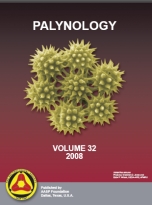Lignites from the Red Hills Mine in Mississippi, U.S.A. contain pollen and spores derived from paratropical swamp vegetation on the U.S. Gulf Coast during the Late Paleocene. Most previous studies of the Gulf Coast sporomorph record have been limited to a restricted taxonomic group, or merely those taxa that are relevant to biostratigraphy, meaning that the true sporomorph diversity may be higher than previously appreciated. Eight samples were collected for palynological analysis from the Red Hills Lignite Mine in Ackerman, Mississippi. All the taxa observed during counting (a minimum of 300 grains per sample) were included in the sample count. Rarefaction, relative abundance distributions, and non-metric multidimensional scaling were used to analyze floral composition, richness, and evenness. The lignite samples are heterogeneous in terms of composition and relative abundances, indicating patchiness in the swamp communities. Clay horizons representing temporary marine incursions contain significantly higher proportions of bisaccate pollen, which may have originated a considerable distance inland from the swamps. These samples therefore represent a much larger source area (regional to sub-continental), compared to the local signal contained in the lignite samples. Richness in the Red Hills Mine assemblage is higher than has previously been recorded for the Late Paleocene of the eastern Gulf Coast. This, combined with the recognition of 23 previously undescribed taxa, suggests that a detailed reappraisal of the Gulf Coast Paleocene sporomorph record is needed to improve understanding of the evolution of the North American vegetation type.
How to translate text using browser tools
1 December 2008
The Red Hills Mine Palynoflora: A Diverse Swamp Assemblage from the Late Paleocene of Mississippi, U.S.A
Phillip E. Jardine,
Guy J. Harrington
ACCESS THE FULL ARTICLE
It is not available for individual sale.
This article is only available to subscribers.
It is not available for individual sale.
It is not available for individual sale.

Palynology
Vol. 32 • No. 1
December 2008
Vol. 32 • No. 1
December 2008
diversity
Paleocene
pollen
spores
statistics
swamp
U.S. Gulf Coast




